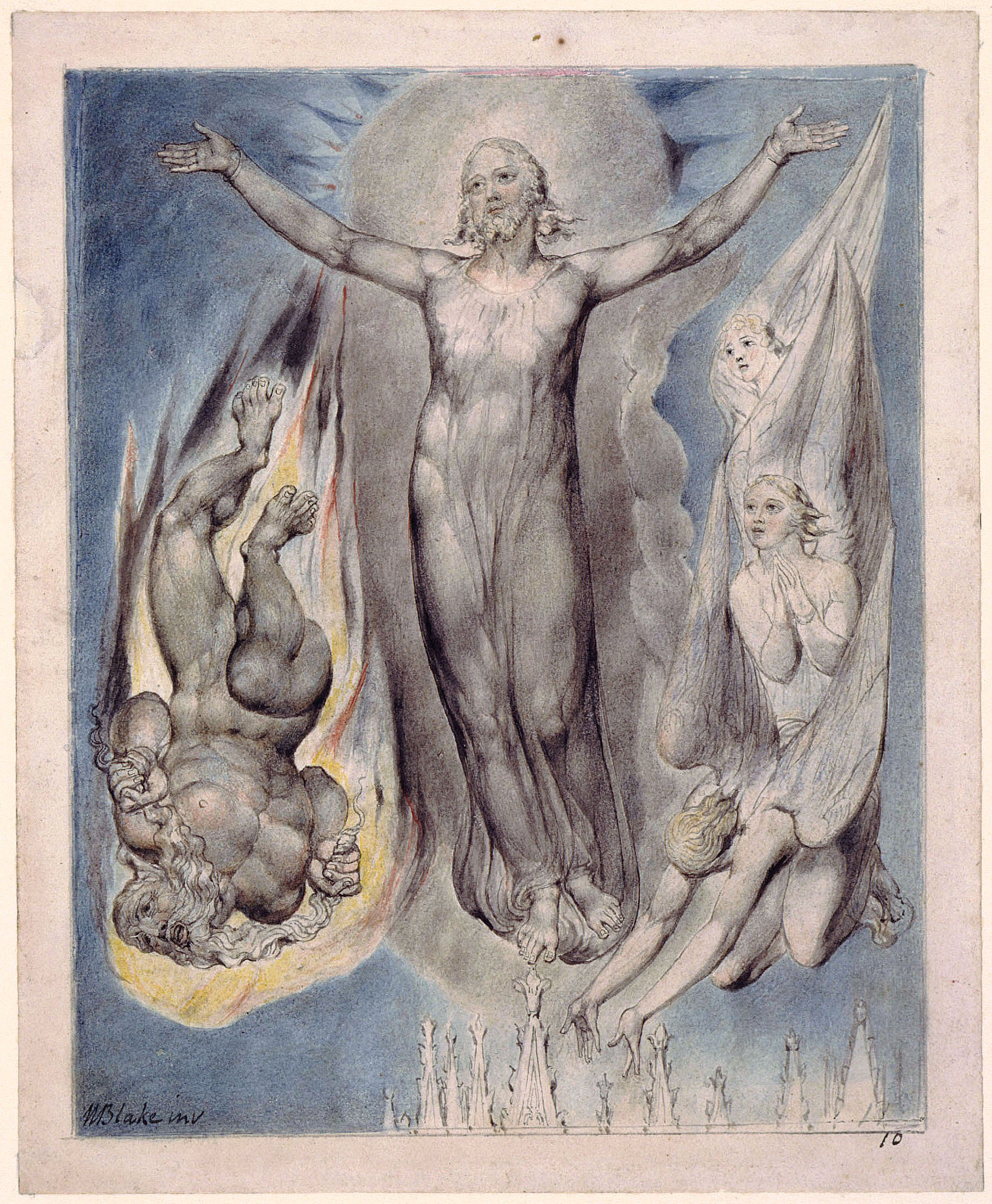minute particular
BLAKE’S ILLUSTRATION OF THE THIRD TEMPTATION IN PARADISE REGAINED
In a recent note in the Milton Quarterly (10 [1976], 48-53) J. Karl Franson compares a number of the illustrations by various artists to the temple spire scene in Paradise Regained, concluding that “only one—William Blake—interprets the scene in close accord with the text of the entire poem.” Further, his illustration “presents a perceptive and convincing interpretation of the crisis, and indeed of the whole work, that resolves much of the apparent ambiguity” in the episode that has made it one of the most perplexing cruxes in the poem (p. 48). More particularly, in contrast to the other Milton illustrators and to his commentators, Blake’s rendition “suggests neither a human balancing feat nor a miraculous intervention” (i.e. support for Christ by the angels), but rather “provocative evidence that Blake is proposing a third alternative, that Christ alone performs the miraculous stand,”1↤ 1 Franson, p. 51. He cites other passages in Paradise Regained (e.g. I, 11; IV, 535-36, 598, 601-03) and The Christian Doctrine as evidence of Milton’s intent. Blake’s illustrations to Paradise Regained are available in a variety of publications: Darrell Figgis, The Paintings of William Blake (London: E. Benn, 1925); Geoffrey Keynes, Milton’s Poems in English (London: Nonesuch Press, 1926); David Bindman, Catalogue of the Blake Collection of the Fitzwilliam Museum (Cambridge: Heffer, 1970); and J. A. Wittreich, Calm of Mind (Cleveland: Case Western Reserve, 1971). The issue of the Milton Quarterly in which Franson’s note appears features the pinnacle illustration, in color, on its cover. that, as Wittreich pointed out earlier, “Christ’s words [on the pinnacle] indicate his own coming to awareness; he now comprehends that which he did not know before.”2↤ 2 “William Blake: Illustrator-Interpreter of Paradise Regained,” in Calm of Mind: Tercentenary Essays on Paradise Regained and Samson Agonistes, ed. Wittreich (Cleveland and London: Case Western Reserve University Press, 1971), p. 121.
While there is little to quarrel with in this general view, there are some additional details that both strengthen Franson’s (and Wittreich’s) case and at the same time reveal a greater complexity in Blake’s illustration than he seems to see. For example, Psalm 91, which Satan refers to (PR, IV, 556-59), speaks of God’s angels being given “charge over” Christ, including the responsibility to “bear thee up in their hands, lest thou dash thy foot against a stone.” Milton’s version, in Satan’s words, is: “in thir hands / They shall up lift thee” (IV, 557-58). But in fact it is Satan who lifts him up and bears him in his hands (“caught him up” and “There on the highest Pinnacle he set / The Son of God”—IV, 541, 549-50). Beyond this textual reinterpretation by Milton of the Biblical passage and Satan’s version of it,3↤ 3 It should also be noted that Satan’s setting Christ “on the highest Pinnacle” (“highest plac’t” as he himself puts it—IV, 553) is parodic of Psalm 91.14: “Because he hath set his love upon me, therefore will I deliver him: I will set him on high . . . ”). Blake positions one of his three angels at Christ’s feet somewhat ambiguously. Is he indicating appropriate obeisance, or offering physical support as if in anticipation of a loss of balance, or calling attention to the lack of physical and divine aid, or gesturing to earth in invitation to the “flow’ry valley” in which they finally “set him down” for the feast of “Celestial Food, Divine, / Ambrosial” and “Ambrosial drink” (IV, 586-90) before Christ returns refreshed “to his Mother’s house” (639)? The answer seems to me a combination of all four, the second and third possibilities reiterating visually Franson’s point that neither physical support nor divine intervention is necessary to steady Christ no matter how “uneasy” his “station” (IV, 584), the “undoubtable ‘proof’ of his divine nature” (Franson, 51).
Blake further enhances this view by the positioning of his angels both in relation to each other and to Christ, and to the plummeting, defeated Satan. Our eye movement over the angels’ configuration seems to me to proceed both downward and upward, each angel being, as it were, a kind of still portrait, the three together constituting a cinematographic sequence. The downward movement, from upright posture to kneeling upright to the gesture of obeisance, is implicitly rejected by the self-sustained Christ. The upward movement from the lowered arms of the bottom angel up through the wings of the other two (echoed in the prayerful hands of the middle angel) reasserts that self-containedness. Contrariwise, Satan to the right of Christ falls heavily, the encompassing mass of flame ironically repeating the angelic configuration, and his divided beard and struggling legs grotesquely parodying the angels’ wings. Thus just as Milton has Satan enact his own challenge to Christ (“if not to stand, / Cast thyself down”—IV, 554-55), so Blake dramatizes the inadequacy of physical strength or balance in his muscular Satan to paralle the superfluousness of aid from the angels.
Finally, Blake’s Christ thus stands between both angelic and physical natures, between youth and age, between heaven and earth (as well as heaven and hell), comprising, yet triumphing over, both in the cruciform position set against the penumbral background of cloud and sky:
Whether thron’dFranson’s conclusion is sound, then: Blake reveals and illustrates “Milton’s fundamental concern in the work,” that is “to dramatize his conception of Christ’s unique nature” (51). But Blake also, via the positional dynamics and spatial movement of his entire illustration, enacts the several complexities and implicit contrasts in Milton’s poem that even more fully than Franson shows illuminate the precise nature of that uniqueness. begin page 127 | ↑ back to top
In the bosom of bliss, and light of light
Conceiving, or remote from Heaven, enshrin’d
In fleshly Tabernacle, and human form. . . .
(IV, 596-99)

